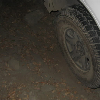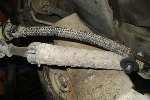I have done the exact same thing to my Explorer and had the same questions.
First of all, Crutchfield is exactly right on their RMS ratings so I dont know what that was about.
As for the amp things, you have two routes. B/c of the Ford setup the amp uses non-standard wiring to connect, so you can't just use it like a regular amp, and can't just plug it up to your aftermarket head unit. The first option uses an electronicn signal converter to absorb the power from your new head unit to a ver low level so that the amp only receives enough signal for it to send out. This also provides connection to your new deck that bridges with the odd plugs of the Ford setup. This will use the amp to power the speakers, which is not very good. The reason you have this is to prevent the unit from feeding 22RMS x 4 of speaker signal to an amp that was designed to receive a low level power/communication signal from the factory head unit.
Your other route, which will basically make your soudn setup standard and ease future upgrades is to bypass the Ford amp altogehter and have the head unit drive the speakers. To do this you use a bypass harness which is basically a bundle of wires with special plugs/adapters at one end to line up with the special Ford plugs. You connect the raw wire ends of this to the speaker outputs on your new head unit and run the wires to the back of the vehicle where the amp is. You then unplug the amps 2 connections (speaker, and power) and connect the harness to the speaker plug which outputs to the speakers, making a direct connection b/t speakers and head unit. Then you tape up the other connections and either leave the amp in or unscrew it and pull it out. The only problem with theis is that its a ***** to do by yourself, but is well worth it in installtion cost savings. You have to remove the right rear quarter panel that lines the rear cargo area as well as the floorboard trim and carpet in order to run the wires. It is not hard, it just takes a while to complete. But in the longrun, the signal is much cleaner, there is no risk of burning the speakers and you have the ability to upgrade at a later time.
So, persoanlly I would go with the bypass. You should also note that signal converters are electronic devices that range from $50-$75, while the bypass harness is only a wiring kit that cost about $7 and that Crutchfield will provide for free if you order from them.
As for the Speakers, the installation is pretty much the same on the 95s as it is on the 91-94s. you just pop out the plugs around the door panel, pull out the little arm handle/trim peice (which also contains all the devices for the power windows, and power doors, all in one simple peice), and then take the panel off. Unscrew the old speaker, unplug, and either plugs up (with Crutchfield connecters), solder, or crimp the connections to the new speaker. Then repart in reverse. Not very hard at all.
On my setup, I noticed a little drop in volume, but only after I installed new Pioneer 3-ways in place of stock. It is not really a volume loss, simply that 3-ways emphesize different sound ranges than the stock ones. And the volume drop was also only in relation to the volume level indicator on my new deck. However, before the speaker change, i noticed no loss and probably a gain in power from the new head unit. The Ford amp operates somewhere around 14-16 RMS. Quite a bit lower than most after markets.
Hope this helps. If not email me for more detail.










